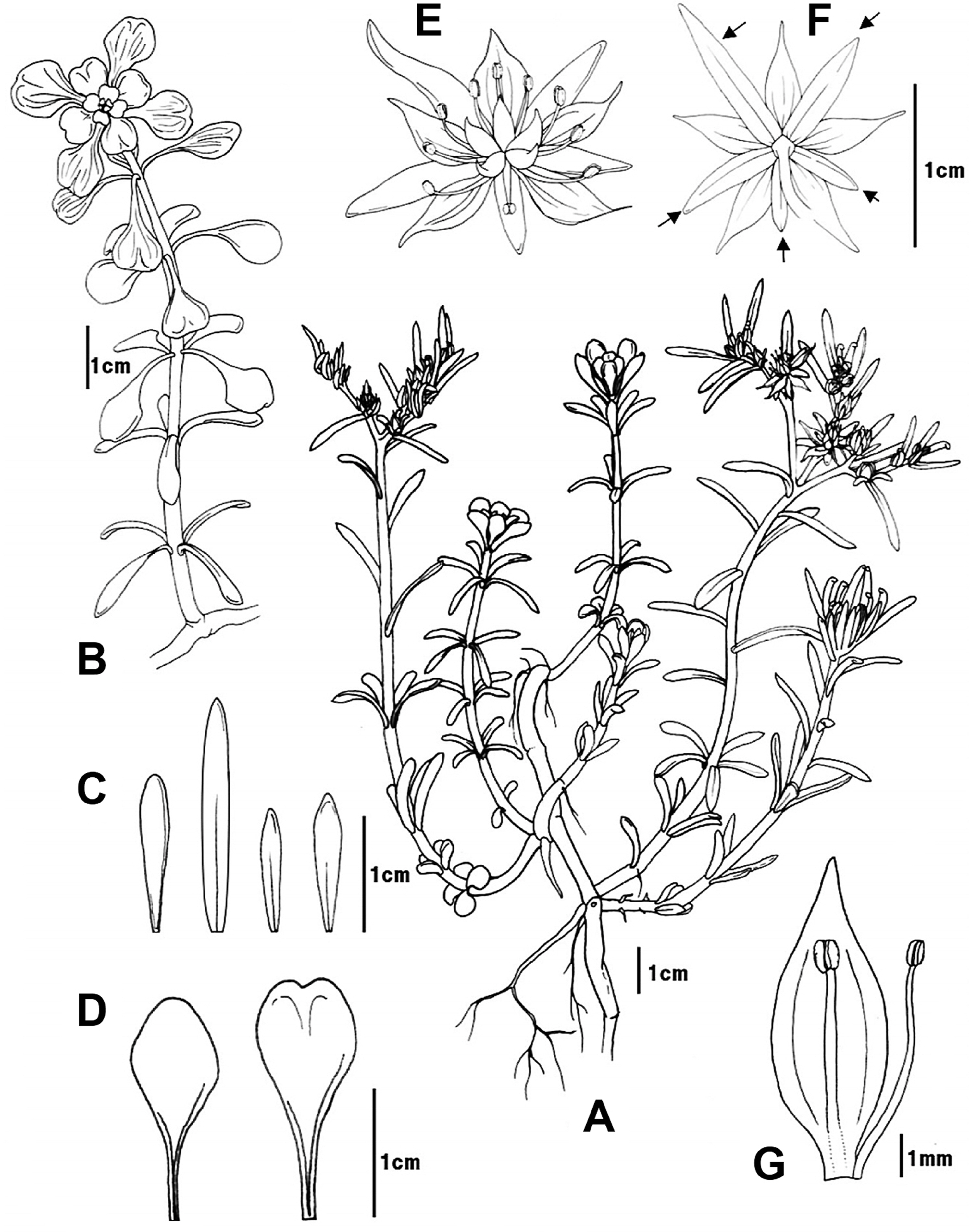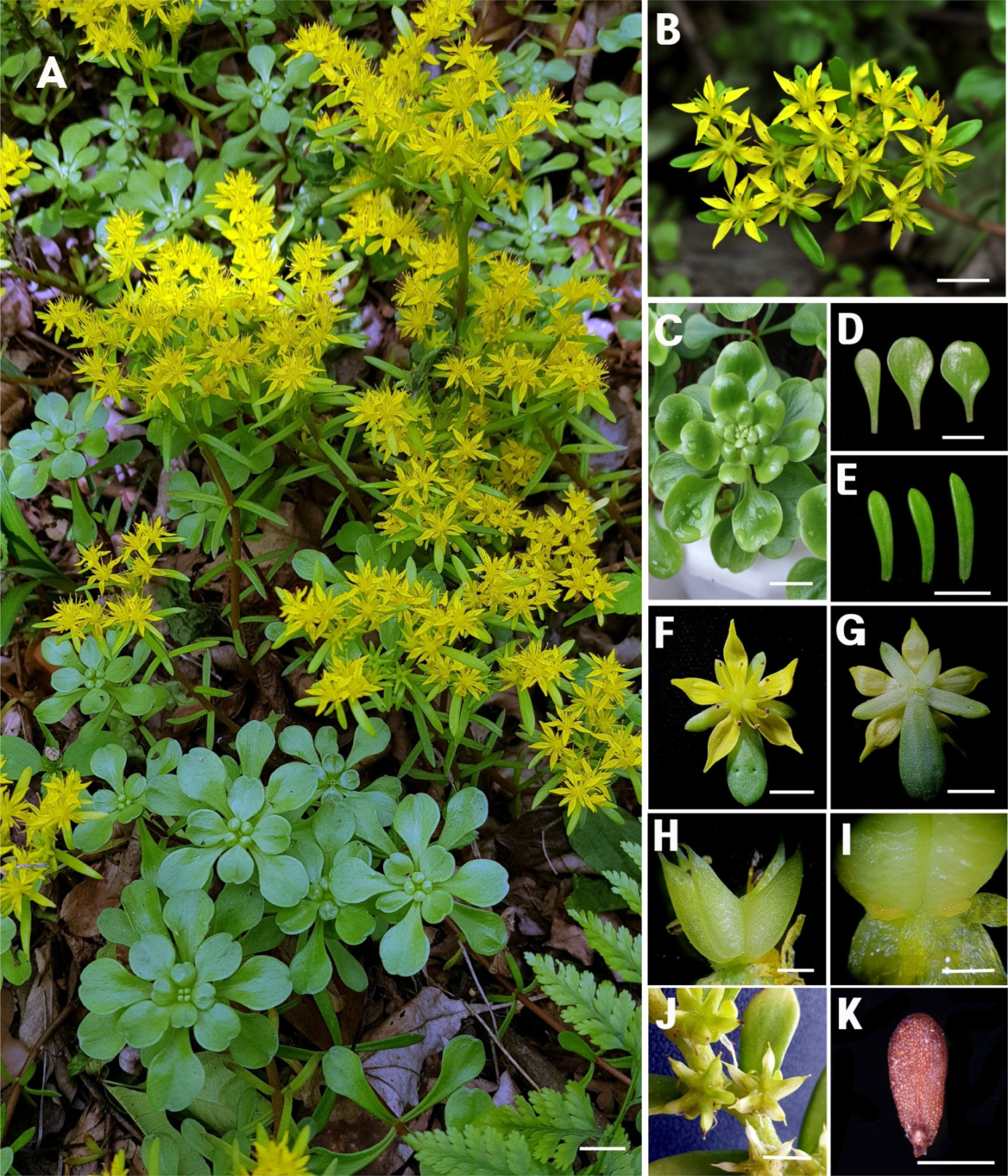A new distribution record of Sedum kiangnanense (Crassulaceae) in Korea
Article information
Abstract
We report a new distribution of Sedum kiangnanense D. Q. Wang & Z. F. Wu on the Korean Peninsula. This species was first reported in China and is distributed in Anhui and Zhejiang provinces. We found this species on Hongdo Island in Heuksan-myeon, Shinan-gun, Jeollanam-do in the Republic of Korea. S. kiangnanense is well distinguished from other species in Korea by 4- or 5-verticillate leaves on the sterile stems and a spatulate leaf shape. We provide its morphological description, detailed illustrations, and a key to related taxa. We have given this species a new Korean name, Ip-kkot-dol-na-mul, which means flower-like leaved sedum.
Sedum L. is one of the largest genera in Crassulaceae, including ca. 470 species in the world and most of them are xerophytic plants (Mayuzumi and Ohba, 2004; Lu et al., 2013: Wu et al., 2013; Ito et al., 2017b). It shows cosmopolitan distribution but the centers of species diversity are the Himalayas, East Asia, Central America, and Mediterranean (Chen et al., 2017; Ito et al., 2017a). This genus consists of annual and perennial herbs with succulent leaves and stems and is primarily distributed in various arid environments including alpine scree, rocky slope, forest floors, mossy rocks, tree trunks, coastal rocks, and exposed limestone (Ito et al., 2017b).
Recent classification system of the genus focused on species in China (Fu et al., 2001) includes three sections: sect. Filipes S. H. Fu, sect. Oreade K. T. Fu, and sect. Sedum S. H. Fu. Section Sedum can be separated from sects. Oeades and Filipes by adaxially gibbous carpels and follicles, while sect. Oeades differs from sect. Filipes by having a spurred (vs. spurless) leaf base and petals that are mainly yellow (vs. white or reddish purple) (Fu et al., 2001). All of the East-Asian species including Korean species belong to the sect. Sedum (Ito et al., 2017a). This section comprises ca. 60 species distributed mainly in Asia: 49 in China (Wu et al., 2013), 18 in Japan (Iwatsuki et al., 2001), and eight in Korea (Moon, 2018).
In this study, we report new distribution of S. kiangnanense D. Q. Wang & Z. F. Wu in Korea based on our collections on Hong-do Island in Heuksan-myeon, Shinan-gun, Jeollanam-do. We provided its morphological description, detailed illustrations, and a key to the related taxa in Korea (Figs. 1, 2).

Illustrations of Sedum kiangnanense D. Q. Wang & Z. F. Wu. A. Habit. B. Sterile stem. C. Leaves on flowering stem. D. Leaves on sterile stem. E. Flower. F. Sepals (arrows) and petals. G. A petal and anthers.

Photographs of Sedum kiangnanense D. Q. Wang & Z. F. Wu. A. Habit. B. Inflorescence. C. Top view of a sterile stem. D. Leaves on sterile stem. E. Leaves on the flowering stem. F. Flower (top view). G. Flower (basal view). H. Carpels. I. Nectar scales. J. Follicles. K. Seed. Scale bars=1 cm (A–G, J), 1 mm (H, I), 0.5 mm (K).
Taxonomic Treatment
Sedum kiangnanense D. Q. Wang & Z. F. Wu, Bull. Bot. Res., Harbin. 10: 45–46, 1990 (Figs. 1, 2).
Korean name: Ip-kkot-dol-na-mul (잎꽃돌나물).
Herbs perennial, fleshy, glabrous, 10–25 cm tall. Roots fibrous at the basal node of stem. Stems stout, erect or ascending from creeping base. Leaves of sterile stems 4–5- verticillate, sessile; lower leaves linear-spatulate to oblanceolate or linear, 6–18 × 2–3 mm, base cuneate to shortly spurred, apex obtuse or rarely acute; upper leaves spatulate, 15–25 (–35) × 10–22 (–30) mm, base abruptly cuneate, apex retuse or truncate to obtuse. Leaves on flowering stems 4–5-verticillate or subverticillate at lower half of the stem, usually alternate at upper half of the stem; blades broadly linear to oblanceolate, 8–18 × 1.5–2.5 mm, base shortly spurred, apex acute. Inflorescences terminal, scorpioid cyme, 3- or 4-branched, ca. 5 cm in diam.; bracts leaf-like, linear-lanceolate or lanceolate, 8–19 mm long. Flowers bisexual, 5-merous, sessile or rarely pedicellate. Sepals unequal; four linear, apex acute, 2 × 0.5 mm; one oblanceolate or linear, apex obtuse, 7.5 (–10) × 2 mm. Petals yellow, broadly lanceolate to lanceolate-oblong, 4– 7 × 2–3 mm, apex acuminate. Stamens 10; antesepalous ones 5, 5–6 mm long; antepetalous ones 5, 4–5 mm long; anthers bright red to red, pollen yellow. Nectar scales flabellate or rectangular, 0.4–0.45 × 0.5–0.6 mm, base slightly narrowed. Carpels 5, ovoid-lanceolate, 3–4 mm long, gibbous ventrally, base connate. Styles ca 1 mm. Fruit follicles, divergent, 6–7 mm long, many seeded. Seeds ovoid-ellipsoid, 0.7–1 mm long, tuberculate.
Flowering: late April to early June.
Fruiting: June to July.
Distribution: Korea (Jeollanam-do), China (Anhui, Zhejiang).
Type: CHINA. Anhui: Huangshan, Tongkou, elev. 430 m, 11 Apr 1988, Wang Dequn 9229, in the Herbarium of Anhui Traditional Medical College (not seen).
Voucher specimens: KOREA. Jeollanam-do: Sinan-gun, Heuksan-myeon, Hong-do Island, 20 May 2017, H.-J. Suh 2019-0001, 2019-0002, 2019-0003 (SWU); 24 May 2018, H.- J. Suh2019-0004 (SWU)*; 11 Apr 2019, J. S. Kim and J. H. Kim kjs19001, 19002 (KB); 1 May 2019, Kim et al. kjs19007, 19008, 19009, 19010, 19011 (KB)*; KIMJH19001, 19002 (KB)#.
Note: *dried specimens; #immersion specimens
A key to Sedum kiangnanense and related taxa in Korea
Leaves verticillate on sterile stems.
2. Leaves 3-verticillate on sterile stems, oblanceolate to oblong ·································· S. sarmentosum 돌나물
2. Leaves 4- or 5-verticillate on sterile stems, spatulate on upper part of sterile stems ···································· ···································· S. kiangnanense 잎꽃돌나물
1. Leaves alternate or opposite on sterile stems.
3. Leaves spatulate, obovate or suborbicular, flattened.
4. Bulblet usually present in leaf axils ····················· ·········································· S. bulbiferum 말똥비름
4. Bulblet absent in leaf axils.
5. Leaf apex round ········ S. makinoi 둥근잎비름
5. Leaf apex emarginate ·· S. tosaense 주걱비름
3. Leaves linear, lanceolate, or oblong, terete or flattened.
6. Leaves terete, apex round; petals 1.5–2 times longer than sepals.
7. Leave linear, 8–18 mm long, somewhat sparsely arranged ···················· S. oryzifolium 땅채송화
7. Leave widely linear-elliptic to oblong, 3–7 mm long, mostly densely arranged ··························· ······································ S. japonicum 돌채송화
6. Leaves flattened, apex acute-acuminate; petals 2.5–4 times longer than sepals.
8. Leaves somewhat sparsely arranged in entire stems at anthesis ············· S. polytrichoides 바위채송화
8. Leaves densely arranged in upper half of stems at anthesis ·············· S. lepidopodum 갯돌나물
Taxonomic note: Sedum kiangnanense was first reported in China and is distributed in Anhui and Zhejiang provinces. (Wang et al., 1990; Fu et al., 2001). In this study, we first report its distribution in Korea. It was found in a southern island (Hong-do Island) in Korean Peninsula in 2016 and confirmed again at the flowering season from 2017 to 2019. As a member of the sect. Sedum, morphology of this species is similar to S. sarmentosum and S. tosaense. However, it is easily distinguished from the species by 4- or 5-verticillate leaves on the sterile stems and spatulate leaves on upper part of the sterile stems (Table 1). Leaf apex in their rosette leaves is also an excellent diagnostic character: S. sarmentosum has acute leaf apex, and S. tosaense has retuse one, while S. kiangnanense has rounded to obtuse one (Table 1). We have given this species a new Korean name, Ip-kkot-dol-na-mul (잎꽃돌나물), which means flower-like leaved sedum.
Two populations containing ca. 200 individuals were confirmed at the edge of the rocky area on the northwestern slope of the hill. The altitude of both of these population sites was ca. 270 m. This species was found under the trees [e.g., Neolitsea sericea (Blume) Koidz., Camellia japonica L., Acer pictum var. mono (Maxim.) Franch., Mallotus japonicus (L. f.) Müll. Arg., Carpinus turczaninowii Hance] and surubs [e.g., Euonymus fortune (Turcz.) Hand.-Mazz., Boehmeria spicata (Thunb.) Thunb.] together with other herbaceous plants such as Hedera rhombea (Miq.) Bean, Trachelospermum asiaticum (Siebold & Zucc.) Nakai, Lemmaphyllum microphyllum C. Presl, Ophiopogon jaburan (Kunth) Lodd., Hemerocallis hongdoensis M. G. Chung & S. S. Kang, Impatiens koreana (Nakai) B. U. Oh, Pseudostellaria heterophylla (Miq.) Pax, Ophiopogon japonicus (L. f.) Ker Gawl., and Ardisia japonica (Thunb.) Blume.
We observed a transition from the sterile stems to flowering stems during the cultivation of the transplanted plants. It was rarely observed when plants do not produce flowering stems. Sterile stems with verticilete leaves turn into flower stems with alternate leaves for a few days, which is presumably adapted to harsh environments.
Acknowledgements
This work was supported by the Sungshin University Research Grant of 2018. Authors thanks to Sang-Hun Oh for the useful comments on this manuscript.
Notes
Conflict of Interest
The authors declare that there are no conflicts of interest.

